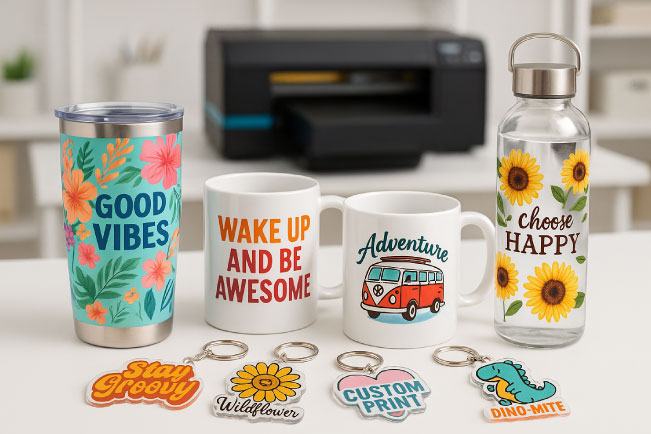In the fast-growing world of printing technology, UV DTF transfers are making waves as one of the most versatile, high-quality, and durable printing solutions. Whether you’re running a small craft business, customizing corporate products, or personalizing gifts, UV DTF printing offers a unique advantage: it can adhere to a wide range of surfaces with stunning color accuracy and long-lasting durability.
But here’s the question many people have: Are UV DTF transfers applicable to different surfaces? The short answer — absolutely yes. The long answer? Well, that’s exactly what we’ll dive into today.
What Are UV DTF Transfers?
Before we explore their compatibility with different materials, let’s quickly understand what UV DTF transfers are.
- UV DTF stands for Ultra Violet Direct to Film.
- This printing process uses UV-curable inks that are printed directly onto a special adhesive film.
- The ink is instantly cured using UV light, creating a vivid, scratch-resistant, and waterproof design.
- The finished print can then be transferred to a variety of surfaces by simply peeling and sticking — no heat press required.
Unlike traditional sublimation or standard DTF transfers, UV DTF prints are more rigid and tactile, making them ideal for non-porous surfaces like glass, metal, and plastic.
Why UV DTF Transfers Stand Out
If you’ve worked with vinyl decals, screen printing, or sublimation, you know that every method has its limitations. Vinyl can peel over time, sublimation only works on polyester or polymer-coated surfaces, and screen printing can be messy and time-consuming.
Here’s why UV DTF transfers are quickly becoming the go-to method for crafters, printers, and small businesses:
- No Heat Needed – Unlike sublimation or heat transfer vinyl, UV DTF decals apply cold, so you can work with heat-sensitive materials.
- Highly Durable – UV DTF prints resist fading, scratching, and moisture, making them perfect for outdoor or high-use products.
- Full-Color, High-Resolution Prints – Achieve photo-quality results with crisp lines and vibrant colors.
- Easy Application – Just peel and stick. It’s that simple.
- Versatility – From stainless steel tumblers to ceramic mugs, UV DTF transfers stick to almost anything.
Surfaces You Can Apply UV DTF Transfers To
Let’s get to the heart of the matter — the many surfaces UV DTF transfers can be applied to. This is where UV DTF technology shines, offering incredible flexibility for both personal and commercial projects.
1. Glass Surfaces
UV DTF transfers are perfect for glass because they create a strong bond without the need for heat.
Common applications:
- Custom wine glasses
- Glass water bottles
- Picture frames
- Car windows
Pro tip: Clean the glass thoroughly with isopropyl alcohol before application to ensure maximum adhesion.
2. Metal Surfaces
Metal products like tumblers, flasks, and signs are hugely popular in the customization world. UV DTF transfers adhere firmly to smooth metal finishes.
Common applications:
- Stainless steel tumblers
- Aluminum signs
- Custom metal tools
- Promotional metal keychains
Pro tip: Avoid applying UV DTF decals to surfaces that flex significantly, as the print layer can crack over time.
3. Ceramic Surfaces
Whether glazed or unglazed, ceramics take UV DTF prints beautifully. Unlike sublimation, you don’t need special coatings or heat presses.
Common applications:
- Coffee mugs
- Ceramic plant pots
- Decorative tiles
- Kitchenware
4. Plastic Surfaces
From acrylic awards to phone cases, UV DTF printing works wonderfully on smooth plastics.
Common applications:
- Custom acrylic signs
- Phone cases
- Plastic containers
- Promotional merchandise
5. Wood Surfaces
While wood is more porous, UV DTF transfers can adhere to smooth, sealed wooden products.
Common applications:
- Wooden plaques
- Key holders
- Home décor signs
- Jewelry boxes
Pro tip: Apply UV DTF decals to sealed or painted wood for the best adhesion.
How to Apply UV DTF Transfers Successfully
While UV DTF printing is beginner-friendly, following the right steps ensures maximum durability and a flawless finish.
Step-by-step:
- Prepare the Surface – Clean with isopropyl alcohol to remove oils, dust, or fingerprints.
- Peel the Film – Remove the backing film carefully to avoid touching the adhesive.
- Apply the Transfer – Position it precisely on your surface.
- Smooth It Out – Use a squeegee or credit card to remove any bubbles.
- Peel the Top Film – Slowly peel away the carrier sheet, leaving the print in place.
Benefits of Using UV DTF Transfers Across Multiple Surfaces
- Versatility in Product Range – Expand your business offerings from drinkware to décor without changing printing methods.
- Cost-Effective Production – One UV DTF printer setup can handle dozens of surface types.
- Time Efficiency – No heat press means faster turnaround times.
- Durability for Resale – Customers love long-lasting designs that don’t peel or fade.
- Professional Finish – Smooth, vibrant prints add a premium feel to products.
Limitations to Keep in Mind
While UV DTF transfers work on many surfaces, there are a few cases where extra care is needed:
- Textured surfaces – Heavy texture may reduce adhesion.
- Fabric materials – UV DTF is not intended for clothing; the prints are rigid.
- Highly flexible items – Constant bending may cause cracking.
How UV DTF Transfers Compare to Other Printing Methods
| Feature | UV DTF Transfers | Sublimation | Vinyl Decals | Screen Printing |
| Works on many surfaces | ✅ | ❌ | ✅ | ❌ |
| Heat required | ❌ | ✅ | ❌ | ✅ |
| Durability | ✅ | ✅ | ❌ | ✅ |
| Waterproof | ✅ | ✅ | ❌ | ✅ |
| Full-color printing | ✅ | ✅ | ❌ | ✅ |
Best Practices for Long-Lasting UV DTF Prints
- Always clean surfaces before application.
- Store unused UV DTF transfers in a dry, cool area.
- Avoid prolonged exposure to harsh chemicals.
- For outdoor items, consider adding a clear coat for extra protection.
Popular Business Uses for UV DTF Transfers
- Custom Drinkware – Tumblers, mugs, and bottles.
- Corporate Branding – Promotional items like pens and keychains.
- Home Décor – Signs, plaques, and wall art.
- Event Merchandise – Wedding favors, party gifts, and giveaways.
- Car Decals – Weather-resistant and vibrant.
FAQs About UV DTF Transfers on Different Surfaces
Q: Can UV DTF transfers go on fabric?
A: No, UV DTF transfers are rigid and are best suited for hard, smooth surfaces.
Q: Will UV DTF prints peel off?
A: When applied correctly to a clean surface, they last for years without peeling.
Q: Are UV DTF decals dishwasher safe?
A: Hand washing is recommended for longer print life, even though they are water-resistant.
Q: Can I apply UV DTF to textured wood?
A: Yes, but sealing the surface first ensures better adhesion.
Yes, UV DTF Transfers Work on Many Surfaces
So, are UV DTF transfers applicable to different surfaces? Absolutely. From glass and metal to plastic, ceramic, and even sealed wood, UV DTF printing offers a versatile, durable, and visually stunning way to customize products without the need for complex equipment or heat pressing.
For businesses, this means you can expand your product catalog without investing in multiple printing systems. For hobbyists, it’s a creative playground with endless possibilities.
Whether you’re making custom UV DTF decals for tumblers, printable UV DTF stickers for glass, or personalized ceramic mugs, the possibilities are endless — and your customers will love the premium quality.

